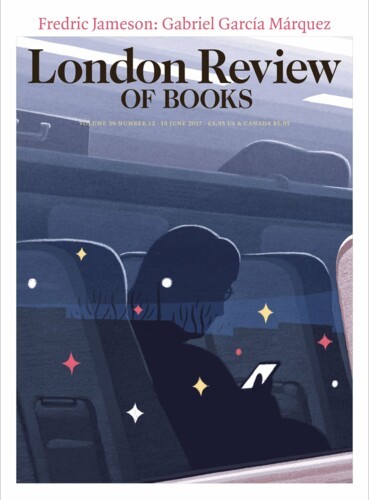In June, I flew from Santiago to Arica, Chile’s northernmost city. Arica lies on the Pacific coast at the edge of the Atacama desert, eleven miles from the Peruvian border. It is known as the ‘city of eternal spring’, and even in the taxi from the airport the air was drier than in the capital, and it was warm enough for short sleeves. When I told my driver that I had travelled from England to see the mummies of the vanished Chinchorro people, he boasted that they were better known internationally than they were in Chile. This isn’t entirely accurate. Most of the Chileans I spoke to had heard of them. In 2021, the Arica and Parinacota region was designated a Unesco World Heritage site, in recognition of its three Chinchorro settlements containing the ‘oldest known archaeological evidence of the artificial mummification of bodies’, whose ‘material, sculptural and aesthetic qualities’ reflected the ‘fundamental role of the dead in Chinchorro society’.
La Muy Ilustre y Real Ciudad San Marcos de Arica (the ‘very illustrious and royal city of San Marcos de Arica’) was established by Philip II in 1570 as an entrepôt for silver from Potosí. It wasn’t long before it attracted the attention of English and Dutch privateers. In 1604 the city was devastated by an earthquake and tsunami. In 1821, following the end of Spanish rule, Arica became part of newly independent Peru. It was conquered by Chile in 1880 during the War of the Pacific, and since then its population has grown to around two hundred thousand.
Almost a fifth of Arica’s population lives below the poverty line, often in poor-quality housing in the surrounding hills and valleys. In 1984, the Swedish mining company Boliden paid a local firm, Promel, to process twenty thousand tonnes of toxic waste containing large quantities of arsenic. Promel was supposed to sell on the waste, but much of it was never processed, and a sludge pile that had been dumped 250 metres from a residential neighbourhood began to be used as a children’s playground. Twelve thousand people were affected by the contaminants, many contracting cancer and other diseases related to toxic materials. None of them has received compensation.
The first excavations of mummified remains in Arica were carried out by the anthropologist Max Uhle on Chinchorro Beach in 1917. It wasn’t until the final decades of the 20th century, however, that anthropologists and archaeologists began to ask why the Chinchorro, who inhabited a 400-mile stretch of the Pacific coast from around 7000 BCE, had mummified their dead. The Chinchorro lived in small, scattered groups and used simple tools made from bone and shell to maintain a diet of fish, sea lions and other animals. They wore only skirts and loincloths. Yet around seven thousand years ago – roughly two thousand years before the Egyptians – they began to mummify their dead. Their mummification techniques demonstrated a good understanding of human anatomy. The Chinchorro peeled back the skin of the deceased and removed the internal organs and soft tissue, before replacing them with straw or clay. They strengthened the arms, legs and spine with sticks, and used reed ropes to bind them to the skull. They then covered the face of the dead person with painted clay masks and attached wigs made from straw or animal hair.
Had these mummies not originated in the Atacama, very few of them would have survived. The desert’s arid climate and nitrate and saline-rich soil have helped preserve them. Bodies of soldiers from the War of the Pacific, Chinese guano workers, Inca copper miners, those ‘disappeared’ by the Pinochet regime and the victims of serial killers have all been found in the Atacama, often in much better condition than those who left them there would have wished. Chinchorro remains have sometimes been mistaken for victims of executions carried out under Pinochet, and vice versa.
In 1868 the crew of the American warship the Wateree witnessed the most destructive of the area’s earthquakes, which reduced much of the city to rubble in less than ten minutes. Fifty minutes later a 39-foot tsunami swept through Arica and smashed into the Morro, a cliff overlooking the city, revealing a number of Indigenous graves. Admiral L.G. Billings later recalled that he and his crew watched from the deck of the Wateree as ‘the mummies of the long-buried and forgotten aborigines rose to the surface’ in ‘a sitting posture, facing the sea’. It seemed ‘to our excited imagination’, he went on, ‘as if the day of judgment had come’.
Some of these remains found their way to the Smithsonian, but most Chinchorro mummies are now in the possession of the University of Tarapacá. The university’s archaeological museum is located eleven miles outside Arica, in a former oasis filled with palm and plantain trees. The Chinchorro exhibits are kept in a grey, block-like building next to the ruins of a colonial hacienda. Darts, spears, arrowheads, basketry and bone tools for scooping out shellfish attest to the skill, ingenuity and resilience that enabled the Chinchorro to survive on the coast of the Atacama for so long.
The mummies are displayed prone on benches behind glass screens in semi-darkness, as if floating on rafts. Most have masks that recall Klee or Miró paintings, with slits or holes for the eyes and mouth. Many have lost their feet and hands, and a few don’t have faces, but others are so well preserved that you can see the wrinkles on their hands. One of the most striking features of the Chinchorro funerary practices was their egalitarianism. Unlike the Egyptians, the Chinchorro mummified every member of the community, from the oldest adult to the youngest child. One display case contains an embryo attached to a stick onto which eyes and a mouth have been carved.
No one knows for sure why the Chinchorro began to mummify their dead, but scholars believe it may have been a response to high mortality rates, caused by the extreme desert environment and the presence of natural arsenic in the Camarones River. Miscarriages were common, and children often died young. I spoke to Bernardo Arriaza, an expert on the Chinchorro, at one of the university’s buildings in downtown Arica. By transforming a dead child or relative ‘from a decaying corpse into a beautifully preserved mummy … with lifelike features’, he told me, the Chinchorro created a ‘living entity’ that took its place in the community. The eyes and mouths of the mummies were left open to allow a channel of communication between the living and the dead. ‘With the Chinchorro there was this fuzzy boundary between life and death,’ Arriaza said. ‘The bodies and the living share the same space, share the same reality.’
Something of this dynamic has endured. There are still people in Arica who will tell you that they played football with Chinchorro skulls during their childhood and stumbled across Indigenous graves on expeditions to the countryside or while carrying out repairs to their homes. In 1983, workers laying pipes found more than a hundred mummified corpses buried in a ditch. In 2004, another Chinchorro burial ground was uncovered at the foot of the Morro during building work on a hotel. These remains were considered so fragile that the university built a second museum around them, the Museo de Sitio Colón 10, named after the street in which the remains were found. On my visit a guide watched carefully as I walked onto the glass case and looked down on the rows of skeletal remains. Unlike those on display at the anthropological museum, these bodies date back to the late Chinchorro period (2000-1500 BCE).
Most people in Arica know what to do when they find Chinchorro remains. This is largely because of the University of Tarapacá’s outreach programme. In order to secure World Heritage status, Arriaza and his team had to show that the Chinchorro sites were protected, and they recognised that this couldn’t be guaranteed without the participation of the wider public. In 2019 the Corporación Chinchorro Marka was founded to manage the archaeological sites and to organise educational sessions on the Chinchorro at schools, residents’ associations and old people’s clubs.
At the corporation’s offices, the archaeologist and outreach officer César Borie described the way he and his team have tried to reconcile the tensions between ‘Jurassic Park-style mass tourism’ and protecting the Chinchorro heritage. ‘It’s a big challenge to make this look interesting in terms of tourism,’ he said. ‘We don’t have Machu Picchu or the pyramids. What we have are the Chinchorro mummies that are mostly in museums, so you have to teach the public what they are looking at and what they are walking over.’ One of the activities organised by the corporation involves placing bone replicas in a sandbox where children and adults can learn how to handle any potential discoveries.
One day, towards the end of my trip, I drove out into the desert and took the Ruta 5, the Chilean stretch of the Pan-American Highway, passing the ever-present animitas, shrines where Chileans memorialise the victims of road accidents. These provided a few patches of colour amid the treeless beige and grey. After two hours I turned off the little road that led down to the Bay of Camarones and stopped to admire the magnificent Chinchorro statues by Paola Pimentel, a local artist. The bodies of the sculptures were adorned with pictures of animals, shells, babies and various scenes from Chinchorro life. (Pimentel also makes replicas of the mummies.)
The Bay of Camarones is inhabited by a community of around fifty people, living in jerry-built shacks made from zinc and plywood. I walked down to the beach, where a few people were fishing, then wandered back up to the settlement, where I was eventually met by Jorge Tapias, a part-time guide for the Corporación Chinchorro Marka. Followed by one of his dogs, we walked up to the roped-in compound where some of the first Chinchorro mummies had been found, and made our way up the dirt track along the cliff to the south of the bay. After a few minutes Jorge led me off the path to a gently sloping plateau high above the rocks, where he showed me fishbones, layers of shell middens and traces of fires left by the Chinchorro. He also picked out an arrowhead, remnants of bone tools for scraping out shells and handmade stone mortars. It was strange to see these items just lying around. Hadn’t anyone tried to steal them? Jorge said that few people came to this spot; he always tried to be on hand to guide visitors and ensure that nothing was taken.
As I looked around, I imagined what life might have been like for the Chinchorro. Bioarchaeologists have found widespread evidence of auditory exostosis or surfer’s ear, probably caused by diving for shellfish. Many Chinchorro remains also have fractures to the arms and legs, most likely from slipping on wet rocks. Looking down the slope, I could see how such accidents happened. And yet, for all the challenges of the environment, the Chinchorro managed to live on the edge of this desert for thousands of years.
Around 1000 BCE they disappear from the archaeological record. Some believe that they merged with the early Andean peoples who arrived in the Atacama. The little that we know about the Chinchorro is based on speculation. We don’t know which gods they worshipped, what songs they sang, how their society was organised or how they thought about time. But their commitment to preserving every member of their community ensured that part of their culture still survives.
Send Letters To:
The Editor
London Review of Books,
28 Little Russell Street
London, WC1A 2HN
letters@lrb.co.uk
Please include name, address, and a telephone number.

